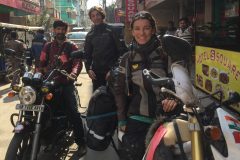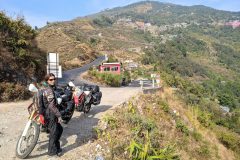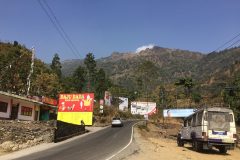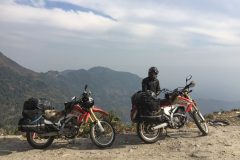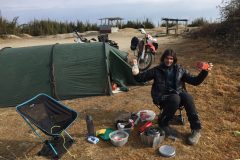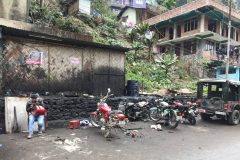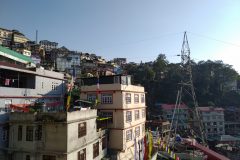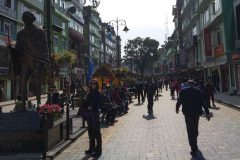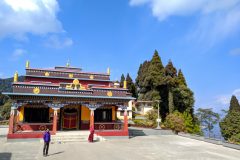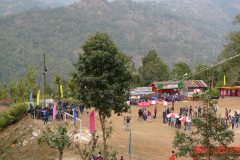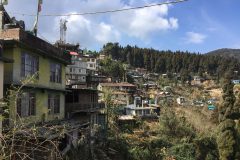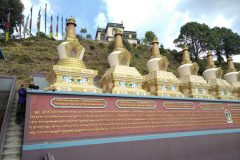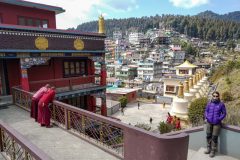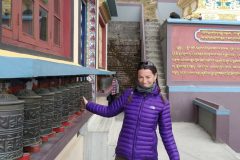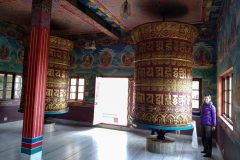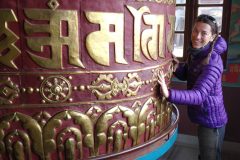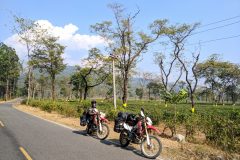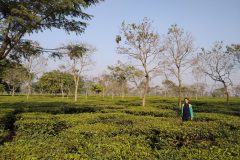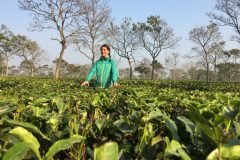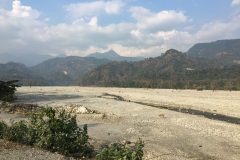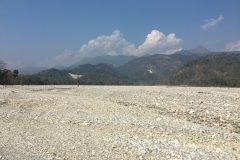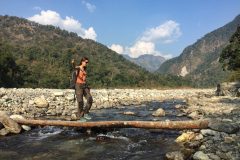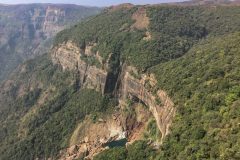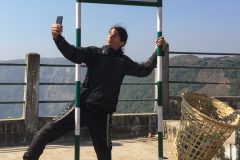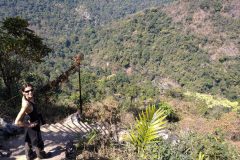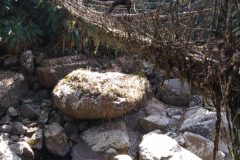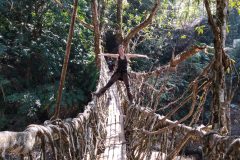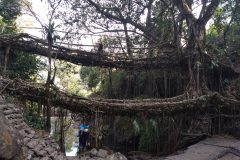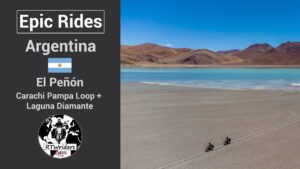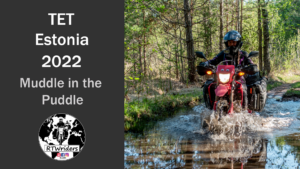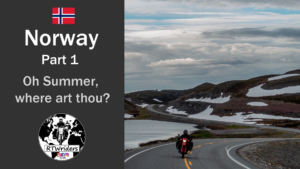Siliguri isn’t very special, but you pass it anyway while travelling north east. We get another biker contact. Raju welcomes us nicely and we spend a night in a cosy hotel. Unfortunately Raju doesn’t have that much time, but we have a great evening and he has very helpful tips for our route and destinations in the whole area.
A bit north of Siliguri the mountains start and it is not far anymore to the famous Darjeeling. As we have become tea drinkers now, we certainly can’t miss it. The little mountain pass leads through many tea plantations. Siliguri is situated at sea level, but only 60 kilometers to the north, we already find ourselves at 2000m a.s.l. in Darjeeling. The view and the landscape is fantastic – Darjeeling itself isn’t that great though. It is not big, but the traffic is terrible. The main street is tiny and completely blocked. We try to find a place to stop, but after half an hour we finally decide, that we rather leave the city as fast as possible and search for a spot to set our tent instead. We end up at a beautiful place nearby a view point called Tiger Hill. Sunsets must be great here, but the weather is quite poor unfortunately.
Although it is off-season we decide to ride further north to Sikkim the next morning. We are aware, that it is not the best season, but we risk to give it a try anyway. The sky looks more and more rainy. In Rangpo is the border to Sikkim and we have to apply for a permit. We need around an hour for the whole process and when we leave the building again, it is already raining heavily. The remaining kilometers to Gangtok, the capital of Sikkim, we get drenched properly and it gets uncomfortably cold, too.
Sikkim is unusually clean and modern. There are signs against littering and plastic bags everywhere. Nobody on the streets honks like crazy and people are relaxed and unintrusive. It is a totally different India.
We are not lucky with the weather and it stays rainy for the next two days. So we go to the tourist information to ask for the weather conditions in the north, where we actually want to ride to. The advice is disillusioning – all roads are closed due to snowfall. The situation to the east of Gangtok is the same. We knew in advance that this could happen, but have been hoping for a chance of snow-free streets.
We are a bit disappointed. The next morning we visit the Hanuman Tok Temple, from where one should be able to see the world’s highest peaks in Nepal. Of course, the weather doesn’t cooperate and Kanchendzonga is hidden in grey clouds.
We have no choice, but to return the same route south again as a start. However we ride eastwards as soon as possible to reach the Neora Valley National Park and sleep in the small village Lava. Some parts in this area look astounding similar to the German Black Forest. Unfortunately, despite of the village’s name, it is also as cold as in the Black Forest after the sun went down. The people don’t seem to heat their houses in this area, or maybe it is just not cold enough yet. So we survive the night with a few wool blankets and our down sleeping bags in our cosy hotel room.
The next day we search for the National Park entrance. It is not obvious at all and we have to ask some locals. They send us to a kind of “ranger station” – basically a simple hut, with a man drinking tea at a desk. We explain to him with gestures, that we want to go for some hiking in the National Park. It turns out, that we need a guide and the maximum duration of stay would be only 1,5 hours. Great – that’s just enough time to walk a few hundred meters, “have a pee” and return. All for the price of ~17€ – what the heck! We kindly decline and feel a bit annoyed while walking back to our hotel. We decide to visit Lava’s nice temple and hike to a nearby village instead. The region is beautiful and there are only a few people, but the National Park is useless for tourism.
After breakfast we leave the mountain area and drive on to Alipurduar. We want to try to visit an Indian National Park one more time. Our destination is the nearby Buxa Wildlife Sanctuary, where you apparently have a chance to see wild rhinos and elephants – in theory even tigers. At the entrance is a barrier and a sign as usual, showing the presence of a National Park. The admission fee for foreigners is a multiple once again, but that’s nothing new. In the park itself, we have a hard time to find the right way. A few kilometers further, we reach another barrier, where a few “ranger” guys play with their smartphones and wait for customers. We ask them for the trailhead. When they start looking at us a bit confused, it already doesn’t bode well. “You have to book a tour, otherwise there isn’t a permission for anything”, one of the guys explains to us. “Elephant riding or Jeep tour?” – “What? Actually we would like to go for a hike.” – “Hiking is not possible, you need a pre-booked tour for that!” – “What the hell? So what was the admission fee for then?”. We are quite pissed off and park our motorcycles at a turn-around area next to a huge dried out river bed. It is easy to see tracks of the Jeep tours. They seem to cross the river bed and follow it along the river to the north. Some locals are present and they tell us, that it is no problem to walk there. So we leave our bikes and follow the Jeeps on foot. We catch up with the Jeeps after a few kilometers, where they all park at a small waterfall. It is nothing special, but there are a few snack shops and a little shrine in a cave. Certainly no wildlife – maybe also due to the dozens of Jeeps driving around all day with ear-battering Bollywood sound? Our hike is ok in the end, but we decide, that it is not worth to visit Indian National Parks. We tried at least 5 parks. It is always very expensive, usually you need to book an additional tour (elephant, Jeep, etc.), there are no park informations at all most of the time and the Indians have probably never even heard of a visitor centre. Basically, Indian National Parks are barred districts with a ticket counter, where foreigners can spend their money on expensive Jeep and elephant tours to have some action fun.
The next two days we ride to Shillong in the state Meghalaya. Meghalaya is one of the regions with the highest average rainfall in the world. So we are very happy, that it is dry season in the moment.
Not far from Shillong is a small village called Cherrapunji, that is famous for its “Living Root Bridges”. The locals had been forming these bridges with aerial roots for decades. It is unique and exists only at this place in this world. The trailhead is in Tyrna and leads into the valley with hundreds of steps. When we have arrived there, we see crystal clear water for the first time in India – that is definitely something unusual in this country. They ask for an admission fee to enter the big root bridges and, even more surprising, they don’t have extra prices for foreigners. Although there are quite some visitors, the whole hike, the fantastic view and the dense vegetation is worth a visit.
In the night it gets cold again and the weather becomes rather poor. Therefore we stay another 2 days in Shillong, to give us and our gear a proper wash, before we enter the “real” north east of India.

